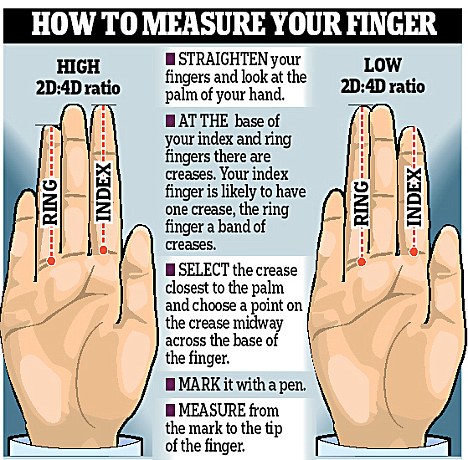
In recent years, a quirky area of research has developed in which researchers measure the length of the second and fourth digits on the hand and foot, calculate the ratio (2d:4d) and then compare this ratio between the sexes. Surprisingly, in many species there are consistent differences between males and females. In mammals, that ratio is smaller for males, whereas in birds, the opposite occurs. But few studies have looked at the other vertebrate classes.
With this in mind, Direnzo and Stynoski recently calculated digit ratios for several common Costa Rica anoles and frogs. The abstract of their paper, published in Anatomical Record last year, tells the story:
“It is now well documented that androgen and estrogen signaling during early development cause a sexual dimorphism in second-to-fourth digit length ratio (2D:4D). It is also well documented that males of mammalian species have a smaller 2D:4D than females. Although there are discrepancies among 2D:4D studies in birds, the consensus is that birds exhibit the opposite pattern with males having a larger 2D:4D than females. The literature currently lacks substantial information regarding the phylogenetic pattern of this trait in amphibians and reptiles. In this study, we examined 2D:4D in two species of frogs (Oophaga pumilio and Craugastor bransfordii) and two species of lizards (Anolis humilis and Anolis limifrons) to determine the existence and the pattern of the sexual dimorphism. Male O. pumilio and C. bransfordii displayed larger 2D:4D than females in at least one of their two forelimbs. Male A. humilis had larger 2D:4D than females in both hindlimbs, but smaller 2D:4D than females in both forelimbs. Male A. limifrons may also have smaller 2D:4D than females in the right forelimb. Finally, digit ratios were sometimes positively related to body length, suggesting allometric growth. Overall, our results support the existence of the 2D:4D sexual dimorphism in amphibians and lizards and add to the knowledge of 2D:4D trait patterning among tetrapods.”
- Evolution in Real Time on Lizard Island - March 23, 2025
- Spider Snags Adult Anolis osa - March 22, 2025
- An Homage to the Green Anoles of New Orleans - March 21, 2025


Thomas Sanger
The results are intriguing by I am bothered by the framework that this research is built around, specifically the author’s broad claims about development. Nearly all developmental studies have been correlational and most often on mammals. Furthermore, only one study that I am aware of, Zheng and Cohn 2011, has examined this trend experimentally. The cited Forstmeier et al. study cited concluded, “that the commonly invoked effect of foetal testosterone on human digit ratio seems to be substantially weaker than the effect described here” further suggesting that the developmental bases of digit ratios may vary between birds and mammals.
Personally, I think that more experimental work is necessary before comparative biologists can begin discussing the developmental similarities and differences among the tetrapod radiations, perhaps even among closely related species. While many sexual dimorphisms are likely due to the differential expression of the steroid pathways this does not necessarily mean that the details of the molecular mechanisms are broadly conserved, that the timing of the hormone’s influence will be similar, or that the environmental contributions are consistent. While potential variation in mechanism is considered briefly in the Discussion, I think that these points need to be made more explicitly. This could be a ripe area of future research for anole biologists , especially through comparisons among species with varying levels of sexual size dimorphism.